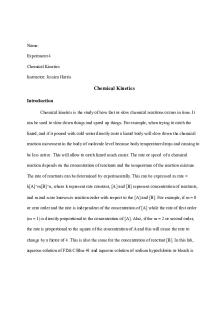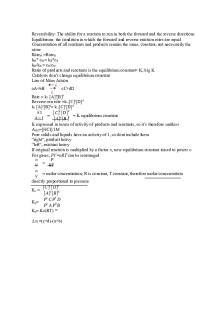Chemistry Lab Report Chemical Equilibrium PDF

| Title | Chemistry Lab Report Chemical Equilibrium |
|---|---|
| Author | Nurul Aimi Johan |
| Course | clinical medicine |
| Institution | Universiti Sultan Zainal Abidin |
| Pages | 4 |
| File Size | 124.8 KB |
| File Type | |
| Total Downloads | 34 |
| Total Views | 160 |
Summary
foundation lab report second last, same as matriculation but only the effect of concentration in chemical equilibrium. About the Le chatelier principle....
Description
When we add the yellow solution of Fe(NO 3)3 to the potassium thiocyanate solution, the color changes to blood red colour, same goes to test tube 2 after it is added with 1ml of 0.1M KSCN solution. Then, in test tube 3, after adding 6-8 drops of 2.5M of NaOH solution, a yellowish brown colour with orange precipitate can be observed. However, the colour of solution in test tube 4 remains unchanged. In general, when we added the Fe(NO 3)3 to the KSCN solution, the color changed to blood red as Iron (III) thiocyanate dissolves readily in water to give a red solution. The red color is due to the presence of hydrates FeSCN 2+ ion. The equilibrium between undissociated FeSCN2+ and the Fe3+ and SCN- ions is given by: FeSCN2+ (aq) ⇌ Fe3+ (aq) + SCN- (aq) In test tube 2, after we added 1ml of 0.1M KSCN solution, the color changes to blood red. In a bit acidic solution will produced red blood color, it emerged because it forming an Iron(III)thiocyanate complex: 3SCN- + Fe ⇌ Fe(SCN)3 The stress applied to the equilibrium system is an increase in the concentration of SCN (from dissociated KSCN). To offset this stress, some Fe 3+ ions react with added SCN- ions, and the equilibrium shifts from left to right or we can say, from reactant to product. Consequently, the red color of the solution deepens. Similarly, on the tube 1, after adding 1ml of 0.1M Fe(NO3)3 solution, the color of solution changes to blood red too because the additional Fe3+ ions from Fe(NO3)3 shift the equilibrium from reactant to product. Meanwhile, on the tube 3 the reaction formed yellowish brown solution with orange percipitate. This reaction is reversible because when NaOH is added to the mixture of 0.1M Fe(NO3)3 and 0.1M KSCN, the volume of reactant will increase, thus decrease the concentration of both of Fe3+ and SCN- ions. Consequently, the product concentration gets higher than reactant hence, the equilibrium shifts to the left from product to reactant. This experiment demonstrates that all reactants and products are present in the reacting system at equilibrium. Second, increasing the concentrations of reactant (Fe 3+ or SCN-) will shift the equilibrium to product while decreasing the concentration of reactant will shift the equilibrium to the reactant. These results are just as predicted by Le Chatelier’s principle. Finally, the test tube 4 just act as a control. A scientific control is an experiment or observation designed to minimize the effects of variables other than the independent variable. This increases the reliability of the results, often through a comparison between control measurements and the other measurements. Therefore, a control group is used as a baseline measures for this experiment, the solution without being given any stress to it.
In this experiment, we will study two equilibrium systems. The equilibrium equation for the reversible reaction of the first system is: Fe3+ + SCN- ⇌ (light brown)
Fe (SCN)2+ (red)
The addition of any substance to the system that increases the concentration of Fe3+ or SCN- will favor the forward reaction. This will cause the equilibrium to shift to the right. The addition of any substance that decreases the concentration of these ions will have the opposite effect.
When potassium thiocyanate, KNCS, is mixed with iron(III) nitrate, Fe(NO3)3, in solution, an equilibrium mixture of Fe3+ , NCS–, and the complex ion FeNCS2+ is formed: Fe3+ (aq) + NCS– (aq) →← FeNCS2+ (aq) (4) yellow colorless red The solution also contains K+ and NO3 – ions, but these are spectator ions and do not participate in the reaction. The relative amounts of the various ions participating in the reaction can be judged from the color of the solution. In neutral or slightly acidic solutions, Fe+3 is light yellow, NCS– is colorless, and FeNCS2+ is red. If the solution is initially reddish, and the equilibrium shifts to the right (more FeNCS2+), the solution becomes darker red, while if the equilibrium shifts to the left (less FeNCS2+), the solution becomes lighter red or perhaps straw-yellow.
The first step in developing your model is to design and carry out three experiments. The goal of the first experiment will be to determine how a change in reactant concentration affects the equilibrium point of a reaction. The goal of the second experiment will be to determine how a change in product concentration affects the equilibrium point of a reaction. The goal of the third experiment will be to determine how temperature affects the equilibrium point of a reaction. For these three experiments, you will focus on the reaction of iron(III) nitrate and potassium thiocyanate. Iron(III) ions react with thiocyanate ions to form FeSCN2+ complex ions according to the following reaction: Fe3+(aq) + SCN–(aq) ⇆ FeSCN2+(aq) Yellow Colorless Orange-Red You can prepare a stock solution of FeSCN2+ by mixing 40 ml of distilled water with 1 ml of 0.1 M Fe(NO3)3 and 2 ml of 0.1 M KSCN. You can then add 2 ml of this stock solution to several different test tubes to create a control condition and several treatment conditions for each experiment. You can then change the temperature, reactant concentration, or product concentration in the treatment conditions as needed and leave the control condition alone for comparison purposes. You must, however, determine what type of data you need to collect, how you will collect the data, and how you will analyze the data for each experiment.
Conclusion Chemical equilibrium deals with extent to which a chemical reaction proceeds. It is observed that most of the chemical reactions do not go to completion i.e., the reactants are not completely converted to products. Chemical equilibrium deals with these reversible reactions, which reach equilibrium state. Chemical equilibrium is where the two opposing processes occur at the same rate, resulting in no change in the system. Chemical equilibrium represents a balance between forward and reverse reaction. In most cases, this balance quite delicate. Changes in experimental conditions may disturb the balance and shift the equilibrium positions that more or less of the desired products is formed. When we say that an equilibrium position shifts to the right, for example, we mean that the net reaction is now from left to right. Variables that can be controlled experimentally are concentration, pressure, volume, and temperature. Here we will examine how each of these variables affects a reacting system at equilibrium.
Part A: Fe3+ + SCN-
FeSCN2+ Equilibrium
1
In five wells on a ceramic spot plate, place 2 drops of 0.05 M NaSCN (sodium thiocyanate), 2 drops of 0.01 M Fe(NO3)3 solution, and 3 drops of deionized water. Make sure you have taken the correct concentrations of each solution. Mix each with a stirring rod; all of the solutions should appear red. 2 Add 2 drops of deionized water to well 1. This well will serve as your color comparison for the following experiments. 3 Add 2 drops of 0.10 M Fe(NO3)3 to Well 2. Record your observations in Data Table A.
4
Add 2 drops of 0.05 M NaSCN to Well 3. Record your observations in Data Table A.
5 Add 1 drop of 0.10 M AgNO3 to Well 4. Record your observations in Data Table A.
6
Add 1 drops of 1.0 M NaNO3 to Well 5. Record your observations in Data Table A. 7 After answering the questions below, rinse the contents of wells 1 - 5 into your waste beaker with a minimum amount of deionized water. Data Table A: Observations for the Equilibrium: Fe3+ + SCN-
FeSCN2+
Question 1: When Fe(NO3)3 was added to the system,
a
Which ion in the equilibrium system caused the "stress"?
b
c
d
Which way did the equilibrium shift?
What happened to the concentration of SCN-?
What happened to the concentration of FeSCN2+? Question 2: When NaSCN was added to the system,
a
Which ion in the equilibrium system caused the "stress"?
b
c
d
Which way did the equilibrium shift?
What happened to the concentration of Fe3+?
What happened to the concentration of FeSCN2+? Question 3: When AgNO3 was added to the system, it caused the precipitation of solid AgSCN.
a
Which ion in the equilibrium had its concentration changed by addition of AgNO3? b Did the concentration of that ion increase or decrease? c When AgNO3 was added, which way did the equilibrium shift? Question 4: When you added NaNO3, did anything happen? Can you explain this result?...
Similar Free PDFs

Chemical equilibrium 1 report
- 9 Pages

Equilibrium - Lab Report
- 9 Pages

Chemical Kinetic Lab Report
- 2 Pages

Lab Report Chemical Composition
- 3 Pages

Chemical Kinetics - lab report
- 4 Pages

Chemical Equilibrium I
- 9 Pages

Worksheet - Chemical Equilibrium
- 8 Pages

Chemistry Lab Report #7
- 7 Pages
Popular Institutions
- Tinajero National High School - Annex
- Politeknik Caltex Riau
- Yokohama City University
- SGT University
- University of Al-Qadisiyah
- Divine Word College of Vigan
- Techniek College Rotterdam
- Universidade de Santiago
- Universiti Teknologi MARA Cawangan Johor Kampus Pasir Gudang
- Poltekkes Kemenkes Yogyakarta
- Baguio City National High School
- Colegio san marcos
- preparatoria uno
- Centro de Bachillerato Tecnológico Industrial y de Servicios No. 107
- Dalian Maritime University
- Quang Trung Secondary School
- Colegio Tecnológico en Informática
- Corporación Regional de Educación Superior
- Grupo CEDVA
- Dar Al Uloom University
- Centro de Estudios Preuniversitarios de la Universidad Nacional de Ingeniería
- 上智大学
- Aakash International School, Nuna Majara
- San Felipe Neri Catholic School
- Kang Chiao International School - New Taipei City
- Misamis Occidental National High School
- Institución Educativa Escuela Normal Juan Ladrilleros
- Kolehiyo ng Pantukan
- Batanes State College
- Instituto Continental
- Sekolah Menengah Kejuruan Kesehatan Kaltara (Tarakan)
- Colegio de La Inmaculada Concepcion - Cebu







